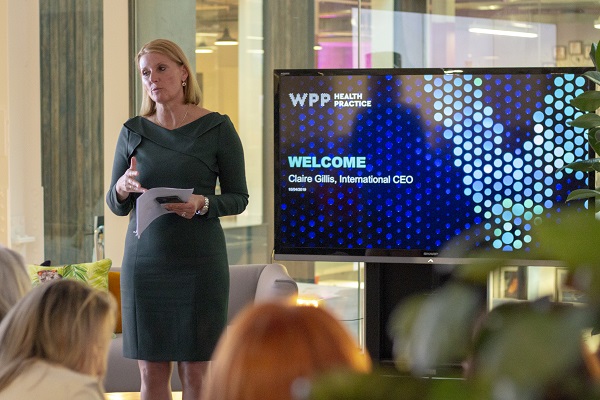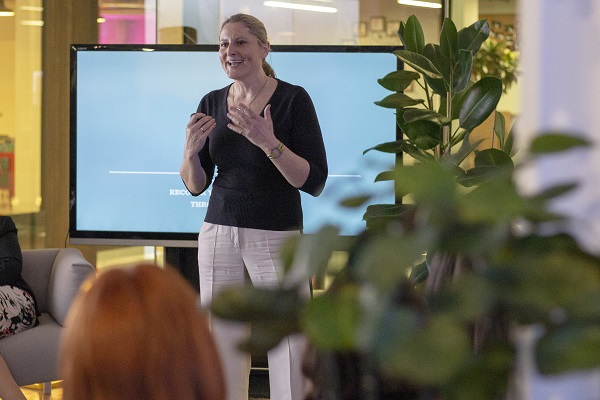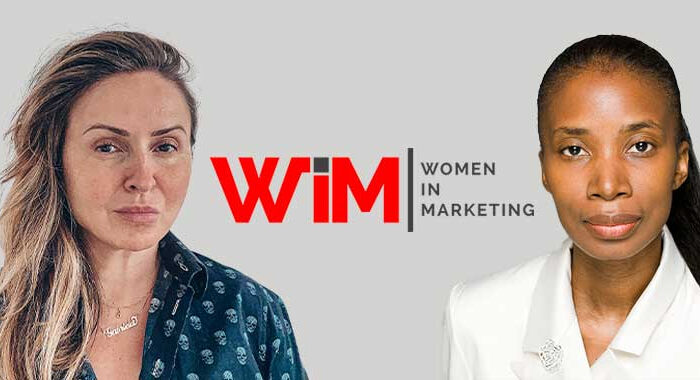The Future of Wellness event – review by Lesley Donnelly, Director, Neon Nelly and a member of the WiM community.
Last month WiM held its first event to look at health and wellness. The Future of Wellness focused on three areas
- Mental health
- The transformation of women in the 40-60 year old demographic
- The future of wellness.
Thank you to our speakers Claire Gillis (pictured above), CEO International, WPP Health Practice; Simon Blake OBE, CEO, Mental Health First Aid England; Zana Morris, Founder, The Clock and Library Gym and Victoria Buchanan, Senior Strategic Researcher, The Future Laboratory.
Special thanks to Natasher Beecher (pictured above), Creative Director, Ogilvy Health & Chair of WPP Health Practice Roots for hosting, and her lovely dog Brodie who stole the show!
The purpose of the latest WiM event, held on 10th April 2019, was to explore the changing attitudes to health and well-being in the workplace, and to explore what role Women in Marketing could play to build a better future.
The event was generously hosted by Claire Gillis, International CEO, WPP Health Practice at their London offices – where the sign on the wall declares ‘Be Well, Do Well’. Speaking with Claire’s team confirmed that they really try to deliver on those values by providing a diverse range of support such as breathing sessions to connect mind and body, meditation groups and education on better well-being practices such as standing desks.
The event was kicked off by Simon Blake OBE, of Mental Health First Aid England, who for a decade has provided training to organisations. Their vision is to normalise society’s attitudes and behaviours around mental health, by developing the skills we need to look after our own and others’ wellbeing.
Simon explained that MHFA England is focused on scaling best practice through systemic change in employers’ processes and structures – there is a strong business case for improving employee well-being, aside from the fact that it is the right thing to do.
He explained some key principles:
- What happens at home impacts work and vice versa and so care for an employee needs to be holistic
- Technology has made employees increasingly accessible and so there is a need to re-calibrate what is an acceptable balance to manage stress and that includes holiday time – everyone needs a complete break away and contact should be discouraged.
- In addition to corporate led initiatives, subtle changes by individuals can have a big impact on well-being culture. Try changing your greeting to “how are you and what are you doing to look after yourself?”hat happens at home impacts work and vice versa and so care for an employee needs to be holistic
- However, progress cannot be maintained if someone is consistently working long hours – good intentions are not enough and at MHFA England they push organisations to look at the hygiene factors and take bigger decisions such as redesigning job roles to have realistic hours.
Simon’s closing message was that progress has been made but much is still do and it starts with leadership role modelling new behaviours around well-being.
Our next speaker Valerie Vamanrav is tackling well-being at a grass roots level. As a successful video producer she started to find there was a lack of balance in her life leading to classic ‘burn out’. Looking for solutions, she discovered how pure organic oils can uplift our physical and mental health. The key advantage being that it is within our control and helps put us ‘in charge of our health’ – we can learn to help ourselves independent of employer initiatives.
Pure oils are powerful and can be inhaled, digested or applied topically as a massage. We breathed in several of the oils to experience the uplifting effects of citrus and also peppermint which is good for memory. The impact of inhaling was pretty instant as it reaches the hippo-campus, your decision making part of the brain and so interrupts mood and alters negative thought patterns. It was a real ‘wow’ effect from a very simple natural source that could be built into a busy routine.
Valerie’s note of caution was that the oil industry is unregulated and it is important to thoroughly research sources as only the very purest oils (such as Doterra) have the transforming impact and are safe to be digested.
Next up was Zana Morris, who has changed my life. I confess that when I read Zana’s resume I assumed she was another of those fitness evangelists whose body shouts ‘look at me, you can be like me’. But that could not have been further from the truth. She is a woman on a mission not to look good, but to help people live strong – both mentally and physically.
First though Zana told us the bad news with a brief human biology lesson:
- We age, because from the age of 30 we have muscle wastage (around half a pound a year); we lose protein and calcium. It gets worse – the muscle comes off the heart and the brain, and so our metabolism slows down. That’s why we experience weight gain.
- She highlighted the hidden dangers of badly planned exercise and diet, e.g.: if you exercise for more than 45 minutes your body starts eating into tissue – so trying to rectify aging by taking up an extreme sport should be done with caution. Nutrition is a minefield too – weight loss from low calorie diets is due 90% to muscle loss thus accelerating aging. We need to focus on losing fat, not muscle.
- Just to make us feel even worse Zana pointed out how much damage our ‘successful’ careers had done to our bodies. Many of us have had 30 years of juggling a fast life with long hours, deadlines and stress without being able to see what this is doing to us internally. It is useful to think of an earlier time before technology when we might be out walking and spot a bear. When we see the bear, Cortisol is released into our system to send chemical messages to RUN. We have outgrown the bears, but everyday there is a Cortisol tug – that email saying the project is behind schedule, the late night copy re-write for the client – the problem is these chemical signals are not meant to linger for 20 or 30 years and so are producing too much sugar and have pushed up our heart rate.
But Zana then brought us out of the valley of despair with tips to tackle insulin resistance as we get older.
- Exercise to live strong
- It doesn’t have to be extreme, walking every day is great
- High intensity training for 8 minutes a day improves not only your muscle strength but your cognitive memory
- Eat to live strong
- Avoid sugars and remember that fat does not cause the body to release insulin so can play a part in a healthy diet
- Mind the gap! Fasting helps stabilise insulin so avoid grazing between meals and allow the body to reset itself
- Don’t eat either side of training – leave a gap of 1 to 2 hours to allow insulin to stabilise.
So having painted a pretty bleak picture about what our body does as we age, Zana gave hope that with discipline and focus on the right things we can all age strong.
The evening was closed by Victoria Buchanan who appropriately used her expertise as a Futures Analyst to paint a picture of well-being trends. Health and well-being has a commercial value as it is now a big part of all brands.
In an era where we can’t escape the news cycle Victoria explained the importance of building personal resilience – sheer volume and negativity has an impact. 39% of US adults said they were more anxious in 2018 than a year ago (American Psychology Association). And even HBR have included the need to build personal and collective resilience for the future as part of its book series.
One argument is that we are losing our resilience as a consequence of the nanny state enabled by technology – how many phone numbers can you dial from memory or are you completely dependent on your mobile? Alexa has the ability to monitor our behaviours and ask us if we have locked the door as we leave the house – is that good, or is that eroding our resilience?
Apps are useful but they are changing how we use our mental memory. 66% believe that we are too reliant and that has led to movements of ‘digital minimalism’ – practical tips to thrive without devices. In the future nations may set personal resilience targets for citizens in order to build a better society which can collectively work through challenges with positive behaviours. At an individual level there will be more focus on neuro-technology to support areas such as identifying what brainwaves cause anxiety.
For brands, the future allows for the possibility to re-frame failure as a positive experience to boost the agility and innovation of a brand by removing a fear of failure.
Event reviewed by Lesley Donnelly, Director, Neon Nelly and a member of the WiM community
Credit for all event images: Helen Watson, Senior Digital Strategist at Ogilvy Health










